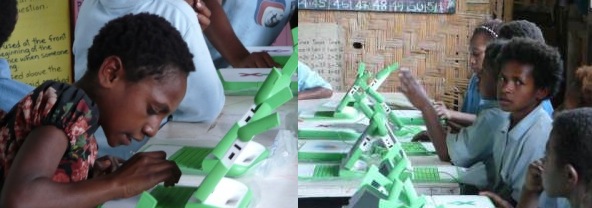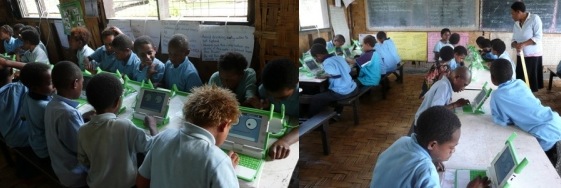
On Monday, Aug. 9, 2010, I visited the Jim Taylor Primary School in Kisap, PNG. Kisap is outside of Banz, which is outside of Mt Hagen by about an hour's drive. The Jim Taylor School is taking part in the One Laptop per Child (OLPC) Initiative that is sponsored by the PNG SDP (Sustainable Development Program), which is the organization in charge of all of the OLPC deployments in PNG.
The PNG SDP is a company that was founded as part of an agreement by the Ok Tedi mine in the Western Province, and its mission is to provide development-oriented projects to improve the quality of life for those affected by the Ok Tedi mining, although this project is being deployed on a wider scale. The Jim Taylor School is a primary school, which in PNG means grades 3-8.
This school has about 450 total students with two classes for each grade level. At this time, grades 3-5 have the XO laptops, with about 245 total laptops having been provided to the school. It's a beautiful school, far back from the main road, and the main path is lined with bright yellow and orange orchids.

All teachers also received an XO, then went through the week-long training provided by the team also in charge of the technology/install. The training and deployment had just taken place the week before, so this was a VERY new project! Their school is the first school in the Western Highlands province, and the third school in the entire country, to receive the OLPC XOs. The staff live in the buildings behind the school. I received an extremely warm welcome at this school, with all the children lining up along the road to welcome me (and the principal) to the school that morning. They had even made a chalkboard sign with my name on it to personalize the welcome.
To my surprise, these teachers told me that before the previous week's training, none of them had ever seen or used a computer before!
As I understood the situation, the teachers had been attending the OLPC training the entire week before my arrival, and since I arrived on a Monday morning, my visit proved the first opportunity for the teachers and students to use the OLPC XOs in a classroom setting. The excitement was palpable.
The 3rd through 5th grade teachers and classes went to set up the XOs and get their classes ready, while I talked with the remaining teachers. After talking with the teachers, Caspar and I made the rounds, checking that the technology that had been installed the previous week was still working correctly, and that the server's signal reached across the school's entire grounds, including to the staff housing. (In PNG, primary and secondary school teachers live on-campus, both to avoid difficult commutes to rural locales and to promote their consistent attendance.)

About an hour after my arrival then, I made my way to the classrooms. First, a word about the technology: the XOs at this school are being charged by DC Power Share Solar Panels. These Solar Panels were designed specifically for the XOs, charge 6 laptops at a time, and can be left outside, generating maximum power while students and teachers work inside.
I first visited the 5th graders. This class had been preparing for using the XOs, by having drawn three versions of local tribal leaders in costume--they were now to draw these men or women using the "Paint" option on the XOs. There were some really talented artists among the students, and the children were so excited to be using the XOs, they didn't want to break for lunch! We finally broke them up ½ hour in to their hour-long lunch break, to make sure we could all have something to eat!
After lunch, I visited the 3rd grade classes, which had combined into one room for the occasion. These students were using the "Speak" function, which allows students to type in a word, and the XO pronounces it back to them. Again, the students were extremely enthusiastic, and the teachers had difficulty keeping the class quiet--it helped that when they had found the answer, they were to sit, silently, with their hands on top of their heads.

This program was very popular among classes, both in PNG and in the Solomon Islands. A number of teachers throughout the trip told me how much this program helps the students learn to pronounce English words, which is especially helpful in PNG, where a law was passed in 2009, making English the official language of instruction in all schools from grade 3 onwards.
Finally, I visited the 4th grade class, where the students first located another student on the mesh network, and then two students were chosen to bring their laptops outside, where they could measure the distance between two objects, or measure the length of certain objects. The students were just taking the laptops outside to do their measuring when the principal returned to the school, to take me back to Mt Hagen, so it was time for me to leave.
The teachers at the Jim Taylor School were extremely enthusiastic about using these laptops in their classrooms, and this excitement was shared by the students. The technology appeared to be working as planned. I was extremely grateful for the chance to have observed them during their first day of use! It is too soon to comment on longer term outcomes, obviously, but it will be interesting to try to follow up on a future visit.
Laura Hosman is Assistant Professor of Political Science at Illinois Institute of Technology and this post is from her Visit to Jim Taylor Primary School, Kisap, Papua New Guinea
.

